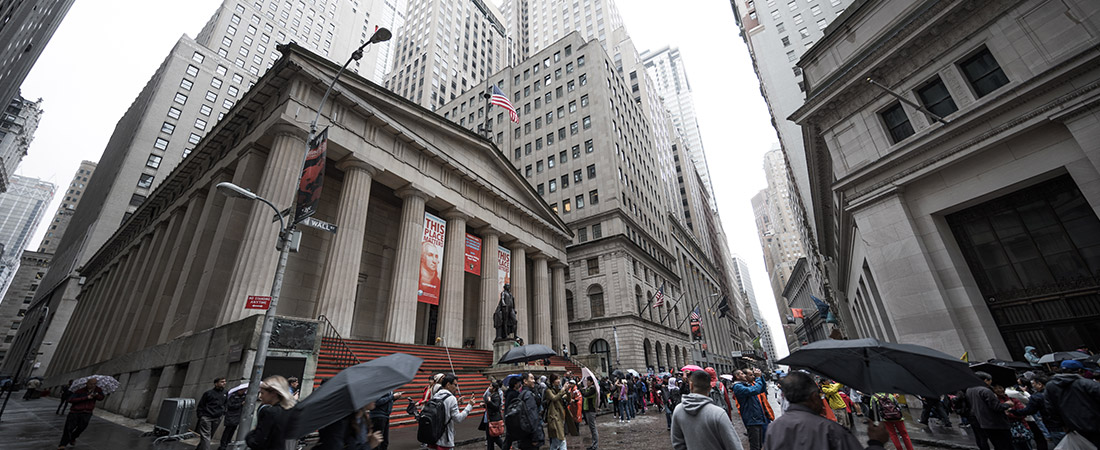Feb 5, 2018
What’s Causing Markets to Drop?
Three explanations for the sell-off: Inflation, interest rates, and full employment.

Last week’s market sell-off continued on Monday, with the Dow Jones Industrial Average shedding another 1,000 points by midday.
The Dow fell 666 points on Friday, which was its largest single-day decline since June, 2016, and the sixth-largest drop in the history of the index. Other indexes, including the S&P 500 and the Nasdaq followed, both dropping about 2% as well, according to reports.
It’s been a sudden turnaround for the stock market, which has risen to record highs over the last 12 months.
So what happened? We’ll explain:
Inflation, interest rates, and employment
Interest rates are rising
The Federal Reserve, the nation’s central bank responsible for setting monetary policy, has been increasing interest rates for the past few years. It did so in twice in 2017; And it’s expected to raise rates again in 2018.
Typically the Fed decreases rates when the economy is doing poorly, as a way to increase borrowing and spending, and it increases rates when the economy is doing well, as a way to apply the breaks when it’s afraid the economy may be overheating.
We’re on track for Gross Domestic Product (GDP) growth of about 5.4% in the first quarter, after years of growth closer to 3%. Too much GDP growth can spark fears of inflation, and with it the prospect of more rate increases.
Businesses, investors, and financial experts fear that both interest rates and inflation are on the rise, which can have a negative impact on the economy and the stock market.
Good to know: An interest rate is what’s charged on a loan, including mortgages, car loans, credit cards, and bonds. Inflation is an increase in the cost of goods and services that make up segments of the economy.
We’re approaching full employment.
It may seem strange, but Friday’s market drop occurred on the same day that the U.S. Department of Labor released positive news in its monthly jobs report. In January, employers added a healthy 200,000 new jobs, and the unemployment rate fell to 4.1%, its lowest rate in 17 years, according to reports.
While that’s great news for workers, The U.S. may be approaching what’s called full employment. In simplest terms, that means everyone who wants a job, or has been looking for one, has found one and is working.
Strong employment tends to push up wages–which have increased by about 2.9% in the past year, according to reports, which can spur consumer spending. And to cope with higher wages, businesses tend to raise their prices for the goods and services that consumers rely on every day, from gasoline for their cars, to toothbrushes and grocery items. All of this increases the risk of rising inflation.
Inflation has been running at levels of less than 2% annually, which is very modest.
But rising inflation can have a negative impact on markets.
Bonds are suddenly more attractive
Bonds, which are generally considered safer investments, are essentially IOUs from a company, city, or the federal government. As the Fed has steadily increased interest rates, the yields on bonds have gone up, too. For something called the 10-year Treasury, which is issued by the U.S. government, the yield has increased to 2.85%, which is half a percentage point higher than what it was a year ago.
Generally speaking, higher yields makes bond buying attractive for some investors, so more money is leaving the stock market for the bond market.
Higher bond rates also increase costs for businesses
Businesses, in particular large public companies, issue bonds to raise money to fund operations. Increasing interest rates can make it more expensive for them to borrow money.
Rising inflation can have a negative impact on markets.
Think of it like your credit card–when the interest rate goes up, it becomes more expensive to charge the things you want or need.
Higher borrowing costs can depress stock prices for public companies.
Is a market drop a bad thing?
Not necessarily.
The current bull market is one of the longest on record. Numerous financial experts and analysts have said the run up in stock prices, and stock indexes–before today, the S&P 500 was up nearly 18% for the year*–can’t be sustained.
And the sell-off could be a sign of things returning to normal, according to some experts.
*Source: Yahoo Finance, February 5, 2018
Related Articles

The 12 Largest Cannabis Companies in 2024

Saving vs. Investing: 2 Ways to Reach Your Financial Goals

How To Invest in the S&P 500: A Beginner’s Guide for 2024

Stock Market Holidays 2024

The 2024 Financial Checklist: A Guide to a Confident New Year

How To Plan for Retirement




